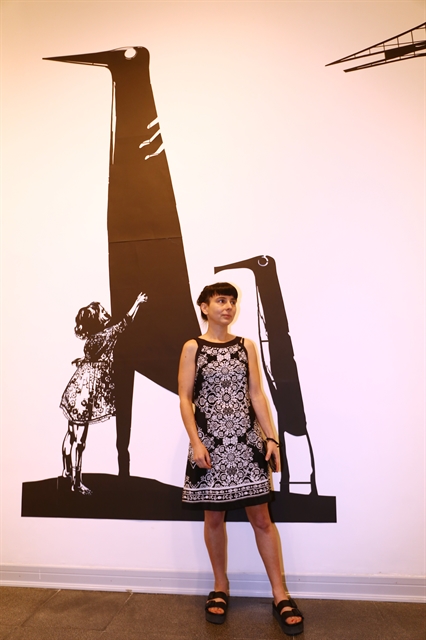 Life & Style
Life & Style

An exhibition entitled A Girl Named K… displaying works by German artist Franca Bartholomai is running at the Goethe Institute until October 27.
An exhibition entitled A Girl Named K… displaying works by German artist Franca Bartholomai is running at the Goethe Institute until October 27.
She was inspired by Vietnamese epic Truyện Kiều (The Tale of Kiều) to create a wall installation of woodcuts and papercuts that offers a whole new view of the time-honoured epic.
Wilfried Eckstein, director of the Goethe Institute in Hà Nội, interviews Bartholomai about the new take on Truyện Kiều.

|
| Artist Franca Bartholomai and her work at Goethe Institute in Hà Nội. Photo coutersy of Goethe Institute |
The exhibition A Girl Named K... is a reflection of your personal approach to the epic Truyện Kiều (The Tale of Kiều). What challenges did you encounter as you processed the literary work?
The text immediately spoke to me. Its visual language was very much in tune with my own: metaphor-heavy imagery.
But that was also exactly the challenge. I carry strong, very intense images inside of me, some of which have been with me since childhood.
It is not always easy for me to open this distinct inner world of mine to alien, external influences. But fortunately, there is some overlap with my world, such as the prophetic dream motif at the beginning, or the conflict between fate and personal freedom, between duty and true love.
As you conceived your artwork, how did you create a synthesis between the enchanting language of Nguyễn Du and the gloom of its plot?
I actually didn’t find the text gloomy, but rather – what should I call it –“realistic”? Kiều experiences awful things.
Sometimes you think it can’t get any worse, but then it does. But there are always moments of hope, of improvement, and in the end, she even returns home to her family and her lover.
It seems as if her life is destroyed and her soul broken. But she lives, and her dignity remains unscathed, despite, or rather, because of her dire fate, even despite the desperation to which she surrendered herself to.
The book does not sugarcoat anything. Life is hard, often cruel, but yet small islands of happiness are always possible.
This“realism”, which is what I call it for lack of a better term, is in stark contrast with artful language, which sounds even “florid” to the European reader.
But this contradiction is precisely what makes the epic so appealing to me - beautiful language to talk about ugliness. Overcoming, sublimating the bad with beauty. This is perhaps the goal, the ideal of all art: to transform evil into beauty.
The medium of woodblock printing is at the center of your artistic work. To what extent does this medium lend itself to the lyrical language of Kiều?
I have already touched on the basic idea. I find contradictions artistically appealing. The point where notions start “grinding” against one another is the point where things get interesting. There is something collage-like about disparities colliding, and I generally like that. It creates a tension that opens the mind and sharpens the senses.
Which works/figures did you enjoy the most - and which have taken the most time and effort?
It is difficult to say. In retrospect, I find that I enjoyed all of it. I like to work. There is no other place where I feel safer and more at ease with myself than at work.
The biggest challenge for me was and still is the long journey, because I have a deep fear of flying.
What relationship do you see between Kiều and the reality women face today in a social or artistic context?
This question triggers a veritable cascade of thoughts in me, which I’m afraid is too much to discuss in this context.
Undoubtedly, times have changed - in Asia as well as in the European western world. No woman today must apathetically be subordinate to her parents or husband. For Kiều, that was a matter of course.
On the other hand, unfortunately, there are still enough situations where women are much worse off than men.
Leadership positions are still mainly filled by men. Works by female artists are statistically worth less than those of their male colleagues. Neither reverse discrimination nor gender-support programmes will change that. Perhaps they are even counterproductive because they institutionalise the “small difference”.
What were your first impressions of Truyện Kiều?
At first, it takes 21st-century European reader a little while to get used to the style. It is a verse epic, very artificial, and the metaphor-rich language seems almost “florid”.
But the content is not. The woman’s fate is difficult, full of unpredictable twists. It is an exciting read from the first to the last line. And it is precisely the remarkable linguistic imagery that triggered something in me and that found its way into my work.
Which aspect of the epic did you focus on in your work?
That is difficult to say, because when I absorb books or pictures, I always tend to let the totality of them sink in and I don’t focus on any specific aspects.
I’m concerned with moods, with feelings – in this case, primarily with the coexistence of despair and devotion, of duty and love.
Kiều may submit to her fate and it almost breaks her, but there are always moments when she improves her situation thanks to her poetic and musical talent.
Rescue, even salvation, through art, creativity and invention is a beautiful and comforting thought that really hit home with me. VNS




